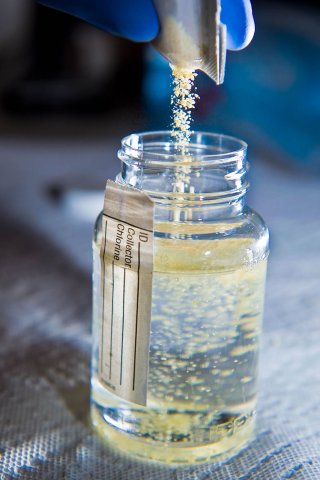
Test your private well annually for total coliform bacteria, nitrates, total dissolved solids, and pH levels. If you suspect the presence of other contaminants, you should test for those also. You can also contact your local health department to find out what substances may be common in your area's groundwater.
You may want to test more frequently if small children or elderly adults live in your house or if someone in your house is pregnant or nursing. These segments of the population are often more vulnerable to pollutants than others.
You should also test your private well immediately if:

In addition, well owners should also determine if the ground water you rely on for household use is under direct influence from surface water. Ground water under the direct influence of surface water is susceptible to contamination from activities on the surface. Direct influence is determined on a site by site basis under state program criteria. To find a state agency to contact, please click here.
The chart below lists common conditions or nearby activities that well owners should be aware of and the substance(s) that you should consider testing for to ensure your well is safe. Not all of the substances listed pose an immediate or long term health problem, some impact quality of life only such as appearance, taste, and odor.
| Conditions or Nearby Activities: | Test for: |
|---|---|
| Recurring gastro-intestinal illness | Coliform bacteria |
| Household plumbing or service lines that contain lead | pH, lead, copper |
| Radon in indoor air or region is radon rich | Radon |
| Corrosion of pipes, plumbing | Corrosion, pH, lead |
| Nearby areas of intensive agriculture | Nitrate, nitrite, pesticides, coliform bacteria |
| Coal or other mining operations nearby | Metals, pH, corrosion |
| Gas drilling operations nearby | Chloride, sodium, barium, strontium |
| Dump, junkyard, landfill, factory, gas station or dry-cleaning operation nearby | Volatile organic compounds, total dissolved solids, pH, sulfate, chloride, metals |
| Odor of gasoline or fuel oil, and near gas station or buried fuel tanks | Volatile organic compounds |
| Objectionable taste or smell | Hydrogen sulfide, corrosion, metals |
| Stained plumbing fixtures, laundry | Iron, copper, manganese |
| Salty taste and seawater, or a heavily salted roadway nearby | Chloride, total dissolved solids, sodium |
| Scaly residues, soaps don’t lather | Hardness |
| Rapid wear of water treatment equipment | pH, corrosion |
| Water softener needed to treat hardness | Manganese, iron |
| Water appears cloudy, frothy or colored | Color, detergents |
Only use laboratories that are certified to do drinking water testing. To find a certified laboratory in your state, you can contact:
Your water test results should include the concentration of the substances you tested for. It may also include whether the substance concentration exceeds a national primary or secondary drinking water standard. In case your test results are not compared to EPA's national health standards, they are provided for your reference:
If a contaminant is found to exceed health standards in your sample, contact your public health department for specific steps to follow and have your well re-tested to confirm the contaminant's presence and concentrations. Some problems can be handled quickly. For example, high bacteria concentrations can sometimes be controlled by adding disinfection to a well, such as: chlorine, ozone, ultra-violet light, and electronic radiation. More specific information can be found in the Center for Disease Control's guide to drinking water treatments for household use.
On-site treatment processes like disinfection, distillation, and filtration may remove the contaminants found in your well water. However, depending on the contaminant, its concentration, and the condition of the well, you may need a new source of water or to drill a new well.
Protect your water supply by carefully managing activities near the water source. For households using a domestic well, this includes keeping contaminants away from sinkholes and the well itself. Keep hazardous chemicals out of septic systems.


In addition to the area near your drinking water well, you should be aware of other possible sources of contamination that may already be present in your community or may be moving into the area.
Consult a local expert to find out the physical and chemical properties of the groundwater you rely on and the presence of any potential drinking water contaminants. Such experts may include, but are not limited to:

Find out about existing and proposed facilities that may pollute your drinking water. Check the local paper for announcements or call your planning or zoning commission to find hearings or zoning appeals on development, construction or industrial projects. Attend these hearings, planning meetings, or zoning appeals. Ask questions to ensure your drinking water will be protected during construction and operation of a facility. Make sure the project has plans for managing storm water and any wastewater it might produce. Request the project's environmental impact statement to confirm it includes a review of drinking water sources.
Flooding, earth quakes, landslides, and other natural disasters can impact the safety of your drinking water by allowing contaminants to enter your private well system. If you suspect your drinking water well may be contaminated after a flood or another natural disaster, contact your local or state health department or environmental agency for advice on inspecting and testing your well. If possible, use a contractor with experience in servicing drinking water wells to inspect and test your well.

EPA provides more specific steps for well owners to follow in its short guide "What to do After the Flood".
Flooding is a common cause of private well contamination. However, there are other emergencies which can impact well water safety. The Center for Disease Control (CDC) has a website dedicated to preparing for, responding to, and surviving natural disasters and severe weather.
Helpful CDC pages for well owners: